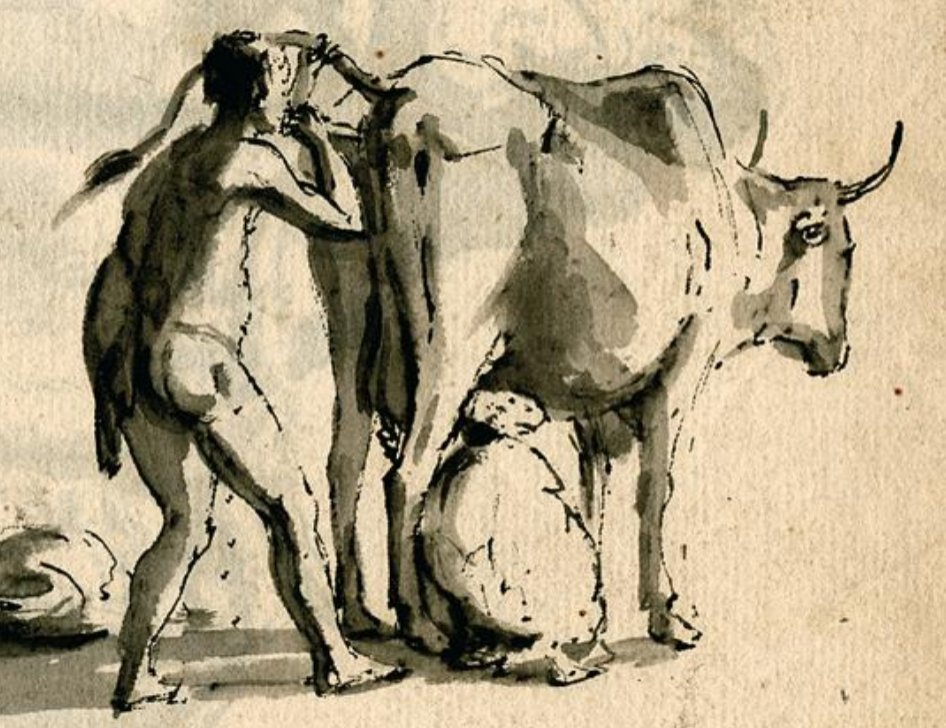As I mentioned earlier in this blog, the Nuer people are strongly linked to cattle in complex ways that are not always understandable to us. What I will describe here is part of this people-cattle interaction that ensures the survival of both in rather harsh conditions.
As with most cattle belonging to African pastoralists, they are of a placid nature and used to constant handling from an early age and milk is probably the most important commodity they produce although sales of oxen are also practiced by the Nuer.
As it is common practice the world over, Nuer cattle are milked after the milk let-down have been stimulated by allowing the calf to suckle briefly and then withdrawn. This action stimulates nerve receptors in the cow teats which induce oxytocin release within a few minutes. This compound, a, hormone causes the cells around the milk-producing alveoli to contract and squeeze out the milk, pushing it down the ducts towards the teat as well as dilating the milk ducts making it easier for the milk to flow down them.
On a visit to a Nuer cattle kraal we came across a very unusual sight, even for a veterinarian that had worked with cattle most of the time. A Nuer woman was blowing strongly, rhythmically and repeatedly into the vagina of a cow for about five minutes, taking rests in between as the effort needed was evidently great.
After the operation, she proceeded to milk the animal, obtaining about one litre of milk. After a while, the process was repeated an more milk obtained.
Enquiries about the practice revealed that the cow had aborted recently but that it was also performed on those cows which have lost their calves or are giving poor milk yields. I took pictures to document the practice and these are presented in a slideshow at the bottom as they are strong pictures that show the operation in great detail.
Later, at the laboratory I checked the literature for this phenomenon and did not find any records of it among the books I had at my disposal. However, I learnt that stretching of the cervix induces oxytocin secretion, increasing uterine motility and probably it also induces milk let-down, probably explaining how the curious practice works.
Years later, in 2010, checking through old papers and pictures I found the notes and prints of the oxytocin observation in Gambela and looked for it on the internet. I found several interesting references to the practice, including one by Wilfred Thesiger during his travels through Sudan [1] and several references to the practice of “cow blowing” in Wikipedia [2] where I learnt that it was quite an ancient and widespread practice throughout the world and that Gandhi stopped drinking cow milk after he came to know about the process known as “phooka” or “doom dev” in India that he considered cruel.
It was the comprehensive work of LeQuellec [3] on the evidence of the practice in ancient cultures that called my attention and prompted me to get in touch with him to discuss my observation. He was interested and encouraged me to publish the observations and so I did [4].
Although the physiological aspects of the practice can be explained, it still leaves unclear in my mind how early “milkers” linked the insufflations with milk let down and started to use it to their advantage. Is it that they have seen milk dripping at calving time? Or is it that they believed the udder to be the end of a continuous system which starts in the vagina and blowing through it will expel the milk? I still do not know.
[1] Thesiger, W. (1983). Arabian Sands. Collins. p.48.
[2] See: https://en.wikipedia.org/wiki/Cow_blowing
[3] Le Quellec, Jean-Loic (2011). Provoking lactation by the insufflation technique as documented by the rock images of the Sahara. Anthropozoologica 46, 65-125. See: https://www.researchgate.net/publication/232693395_Provoking_lactation_by_the_insufflation_technique_as_documented_by_the_rock_images_of_the_Sahara
[4] de Castro, J. J. (2011). Nuer’s oxytocin. Cahiers de l’AARS — N° 15, 27-28.






